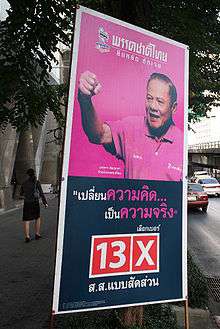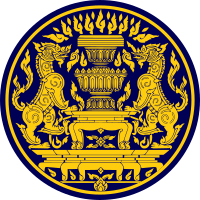Banharn Silpa-archa
| Banharn Silpa-archa บรรหาร ศิลปอาชา | |
|---|---|
.jpg) | |
| 21st Prime Minister of Thailand | |
|
In office 13 July 1995 – 24 November 1996 | |
| Monarch | Bhumibol Adulyadej |
| Preceded by | Chuan Leekpai |
| Succeeded by | Chavalit Yongchaiyudh |
| Leader of the Opposition in House of Representatives of Thailand | |
|
In office 27 May 1994 – 19 May 1995 | |
| Prime Minister | Chuan Leekpai |
| Preceded by | Pramarn Adireksarn |
| Succeeded by | Chuan Leekpai |
| Minister of Transport | |
|
In office 7 April 1992 – 9 June 1992 | |
| Prime Minister | Suchinda Kraprayoon |
| Preceded by | Nukul Prachuabmoh |
| Succeeded by | Nukul Prachuabmoh |
|
In office 5 August 1986 – 3 August 1988 | |
| Prime Minister | Prem Tinsulanonda |
| Preceded by | Samak Sundaravej |
| Succeeded by | Montri Pongpanich |
| Minister of Finance | |
|
In office 14 December 1990 – 23 February 1991 | |
| Prime Minister | Chatichai Choonhavan |
| Preceded by | Veeraopng Ramangkoon |
| Succeeded by | Sutee Singsane |
| Minister of Interior | |
|
In office 9 January 1990 – 9 December 1990 | |
| Prime Minister | Chatichai Choonhavan |
| Preceded by | Pramarn Adireksarn |
| Succeeded by | Pramarn Adireksarn |
| Minister of Industry | |
|
In office 3 March 1988 – 9 January 1990 | |
| Prime Minister | Chatichai Choonhavan |
| Preceded by | Pramual Sabhavasu |
| Succeeded by | Pramarn Adireksarn |
| Minister of Agriculture and Cooperatives | |
|
In office 3 March 1980 – 4 March 1981 | |
| Prime Minister | Prem Tinsulanonda |
| Preceded by | Kriangsak Chamanan |
| Succeeded by | Arnat Arpapirom |
| Personal details | |
| Born |
19 August 1932 Suphan Buri, Siam |
| Died |
23 April 2016 (aged 83) Bangkok, Thailand |
| Nationality | Thai |
| Political party | Thai Nation Party |
| Spouse(s) | Jamsai Silpa-archa |
| Children |
Warawut Silpa-archa Kanchana Silpa-archa Parichat Silpa-archa |
| Profession | Businessman, politician |
| Signature |
|
| Military service | |
| Allegiance | Thailand |
| Service/branch | Volunteer Defense Corps |
| Years of service | 1990-2016[1] |
| Rank | VDC Gen. |
Banharn Silpa-archa[2][3] (also spelled Banhan, Silapa-, Sinlapa-, -acha; Thai: บรรหาร ศิลปอาชา, RTGS: Banhan Sinlapa-a-cha, Thai pronunciation: [ban.hǎːn sǐn.lá.pà.ʔaː.t͡ɕʰaː]; 19 August 1932 – 23 April 2016) was a Thai politician. He was the Prime Minister of Thailand from 1995 to 1996. Banharn made a fortune in the construction business before he became a Member of Parliament representing his home province of Suphan Buri. He held different cabinet posts in several governments. In 1994, he became the leader of the Thai Nation Party. In 2008, the party was dissolved by the Constitutional Court and Banharn was banned from politics for five years.
Early life, education, and business career
Banharn was born on 19 August 1932 in Suphan Buri to a Chinese merchant family.[4] His Chinese name was Tekchiang Saebe (Chinese: 馬德祥; pinyin: Mǎ Déxiáng;[5] Thai: เต็กเชียง แซ่เบ๊). He married Khunying Jamsai Silpa-archa and they have three children.[4]
Banharn dropped out of secondary school during World War II. He went to work with his older brother, then founded his own building company. Years later, when he was a politician, he completed his education at the open admissions Ramkhamhaeng University, graduating with a Bachelor of Laws degree in 1986, and finally a Master of Laws.[6]
Banharn's construction company was very successful in the 1960s, when large sums were invested in major infrastructure projects, including military facilities. His business made Banharn a billionaire.[6]
Political career
.jpg)
Banharn Silpa-archa was persuaded to enter politics by Booneua Prasertsuwan, a veteran member of the House of Representatives.[7] In 1976, Banharn Silpa-archa made his political debut when he was elected a Member of Parliament, representing Suphan Buri Province. He joined the Thai Nation Party, a conservative party dominated by the "Rajakru clan" around Pramarn Adireksarn and Chatichai Choonhavan. His party participated in a coalition government under Prime Minister Seni Pramoj and Banharn was appointed deputy minister of industry. He was elected to the Senate in 1977, but returned to represent his constituency in the House of Representatives the next year. Banharn was re-elected Member of Parliament for Suphan Buri in all following elections, receiving steadily more than 100,000 votes (60 to 90 percent of the votes cast), what made him one of the highest vote-getters in the country.[6]
He sponsored the construction of schools, bridges, and other infrastructure in his home province, which in turn were named after him. This has led to the common saying that he "owns the province".[6] When his party was a junior partner in the government of Prem Tinsulanonda from 1980 to 1983, Banharn was Minister of Agriculture. In 1981, he became secretary-general of the Thai Nation Party. Banharn, being one of the main financiers of the party, accumulated considerable influence inside the party, although he was not a member of the originally dominant Rajakru clan. The local press has once dubbed him "Mr. (Mobile) ATM" (automated teller machine), due to the suspicion that he had bought the loyalty of political associates in exchange for money.[6]
In 1986 Prime Minister Prem again called him up to the government, this time naming him Minister of Transport. After his party had won the elections in 1988 and Thai Nation leader Chatichai Choonhavan had become Prime Minister, Banharn was appointed Minister of Industry. In January 1990, he switched offices with Pramarn Adireksarn and became interior minister. In December of the same year, Chatichai made him Minister of Finance. The Chatichai government was deposed by a military coup d'état in 1991. Banharn returned to the cabinet as early as April 1992, when he once again became Minister of Transport in the short-lived government of General Suchinda Kraprayoon. His party went into opposition after early elections in September 1992. Banharn took over the leadership of the Thai Nation Party from Pramarn Adireksarn in 1994 and also became official leader of the opposition.[4]
Premiership
Under the leadership of Banharn, the Thai Nation Party won the parliamentary election in 1995, and he became the 21st Prime Minister of Thailand, leading a seven-party coalition. Banharn was involved in numerous corruption scandals, one of which diminished confidence in his administration and caused him to resign.[8] His short-lived yet inept administration is believed to have paved the way for the economic crisis of 1997.[9]
During a state visit by Queen Elizabeth II of the United Kingdom in October 1996 he mistakenly referred to her as "Queen Elizabeth Taylor", receiving ridicule and criticism as a result.[10]
Later life and death

On 21 January 2008, Banharn announced that his Thai Nation Party would join a coalition with the People's Power Party, successor to the Thai Rak Thai Party of former Prime Minister Thaksin Shinawatra. Because he had earlier vowed before the Emerald Buddha never to rejoin Thaksin because of the corruption scandals, this move reinforced Banharn's image as a "slippery eel".[11]
Upon the dissolution of his Thai Nation Party by the Constitutional Court on 2 December 2008, Banharn Silpa-archa was banned from politics for five years. Non-executive members of the Thai Nation Party immediately founded the Chartthaipattana Party (Thai National Development), chaired by Banharn's younger brother, Chumpol Silpa-archa. Chumphol was Minister of Tourism and Sports in the cabinet of Abhisit Vejjajiva. His son Warawut was deputy transport minister, and his daughter Kanchana was deputy education minister.[12]
Banharn died of asthma on the morning of 23 April 2016 at Siriraj Hospital at the age of 83.[13][14]
Royal decorations
Banharn has received the following royal decorations in the Honours System of Thailand:
_ribbon.png)
_ribbon.png)
_ribbon.png)
_ribbon.png)
_ribbon.png)
_ribbon.png)
References
- ↑ http://www.ratchakitcha.soc.go.th/DATA/PDF/2533/D/041/1.PDF
- ↑ Biography at www.cabinet.thaigov.go.th Archived 18 June 2008 at the Wayback Machine.
- ↑ The Nation online search
- 1 2 3 "Former PM Banharn dies at 83". Bangkok Post. 23 April 2016.
- ↑ "泰前總理馬德祥過世 享壽83" [Former Thai Prime Minister Ma Dexiang passes away, aged 83]. Yahoo! Hong Kong (in Chinese). 23 April 2016.
- 1 2 3 4 5 Surin Maisrikrod (1992), Thailand's Two General Elections in 1992: Democracy Sustained, Institute of South East Asian Studies, p. 13
- ↑ "Ex-House speaker Boon-eua dies at 97". Bangkok Post. 13 October 2016. Retrieved 26 October 2016.
- ↑ Poole, Peter A. (2009), Politics and Society in Southeast Asia, McFarland, p. 23
- ↑ Sharma, Shalendra D. (2003), The Asian financial crisis: Crisis, reform and recovery, Manchester University Press, p. 100
- ↑ http://russiatoday.com/Politics/2009-08-27/10-silliest-quotes-politicians.html Russia Today
- ↑ "Pro-Thaksin party finalises coalition", The Peninsula, 18 January 2008, archived from the original on 7 July 2012, retrieved 29 January 2012
- ↑ Tumcharoen, Surasak (4 January 2009), "Keeping it in the family", Bangkok Post, retrieved 9 July 2011
- ↑ "บรรหาร ศิลปอาชา" ถึงแก่อนิจกรรมในวัย 83 ปี ปิดตำนาน"มังกรสุพรรณ" (in Thai), ASTV Manager
- ↑ "Former PM Banharn passes away at 83", The Nation, 23 April 2016, retrieved 23 April 2016
External links
| Wikimedia Commons has media related to Banharn Silpa-Archa. |
- Opening Statement – to the Fifth ASEAN Summit
- 'In search of good publicity' – Bangkok Post article
| Political offices | ||
|---|---|---|
| Preceded by Chuan Leekpai |
Prime Minister of Thailand 1995–1996 |
Succeeded by Chavalit Yongchaiyudh |
| Diplomatic posts | ||
| Preceded by Goh Chok Tong |
Chairperson of ASEAN 1995 |
Succeeded by Trần Đức Lương |
